|
|
|
Sort Order |
|
|
|
Items / Page
|
|
|
|
|
|
|
| Srl | Item |
| 1 |
ID:
132768
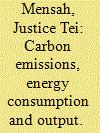

|
|
|
|
|
| Publication |
2014.
|
| Summary/Abstract |
Following the recent global economic downturn, attention has gradually shifted towards emerging economies which have experienced robust growth amidst sluggish growth of the world economy. A significant number of these emerging economies are in Africa. Rising growth in these economies is associated with surging demand for energy to propel the engines of growth, with direct implications on emissions into the atmosphere. Further, these economies are constantly being shaped by series of structural reforms with direct and indirect effects on growth, demand for energy, etc. To this end, this paper examines the causal dynamics among energy use, real GDP and CO2 emissions in the presence of regime shifts in six emerging African economies using the Gregory and Hansen (1996a). J. Econ. 70, 99-126 threshold cointegration and the Toda and Yamamoto (1995). J. Econometrics. 66, 225-250 Granger causality techniques. Results confirm the presence of regime shift effects in the long run inter-linkages among energy use, real GDP and CO2 emissions in the countries considered, thus indicating that structural changes have both economic and environmental effects. Hence, integration of energy and environmental policies into development plans is imperative towards attaining sustainable growth and development.
|
|
|
|
|
|
|
|
|
|
|
|
|
|
|
|
| 2 |
ID:
132763


|
|
|
|
|
| Publication |
2014.
|
| Summary/Abstract |
This paper explores the relationship between trade openness and energy consumption using data of 91 high, middle and low income countries. The study covers the period of 1980-2010. We have applied panel cointegration to examine long run relationship between the variables. The direction of causal relationship between trade openness is investigated by applying Homogenous non-causality, Homogenous causality and Heterogeneous causality tests.
Our variables are integrated at I(1) confirmed by time series and panel unit root tests and cointegration is found between trade openness and energy consumption. The relationship between trade openness and energy consumption is inverted U-shaped in high income countries but U-shaped in middle and low income countries. The homogenous and non-homogenous causality analysis reveals the bidirectional causality between trade openness and energy consumption. This paper opens up new insights for policy makers to design a comprehensive economic, trade and policies for sustainable economic growth in long run following heterogeneous causality findings.
|
|
|
|
|
|
|
|
|
|
|
|
|
|
|
|
| 3 |
ID:
132833
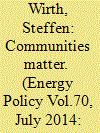

|
|
|
|
|
| Publication |
2014.
|
| Summary/Abstract |
Energy transitions are high on political agendas. From a practical viewpoint, community approaches are deemed essential in order to transition from a predominantly centralized energy supply to a decentralized one, and to exploit the potential of renewable energies. In this paper, I discuss how the emergence of community-based energy projects can be analyzed from an institutional perspective. In this context, a 'community' is treated as an individual institutional order that shapes decisions. I examine how community structures the implementation of biogas cooperatives in the Autonomous Province of South Tyrol in Northern Italy. My findings suggest that 'community spirit', a cooperative tradition, and the norms of locality and responsibility are central drivers behind the emergence and constitution of biogas cooperatives. Not only do these institutional features of community influence the decision concerning which farmers are in or out but also plant location and scale. I argue that 'community' is a necessary analytical category for understanding community energy.
|
|
|
|
|
|
|
|
|
|
|
|
|
|
|
|
| 4 |
ID:
132746


|
|
|
|
|
| Publication |
2014.
|
| Summary/Abstract |
The industrial sector consumes about 50% of the world×s delivered energy and thus has a large impact on the world×s energy production and consumption. Japan is one of the leading countries in industrial efficiency while China is the world×s largest industrial energy consumer. This study analyzes the energy consumption and efficiency of the Japanese and Chinese manufacturing industry. Analysis shows that the energy intensity of both Japanese and Chinese manufacturing industry has decreased significantly. Decomposition analysis shows that the efficiency effect played an important role in reducing energy intensity; improvement of the energy efficiency of both Japanese and Chinese manufacturing industry showed a trend of exponential decay. Structural effect significantly reduced the energy intensity of the Japanese manufacturing industry while having a relatively small influence on the energy intensity of the Chinese manufacturing industry. Our analysis also shows a strong association of industrial energy efficiency improvement with energy policies, highlighting that energy efficiency policies can play an important role in the reduction of industrial energy intensity. The results of this study also underscore the important, yet very challenging, task of achieving structural change to further improve efficiency.
|
|
|
|
|
|
|
|
|
|
|
|
|
|
|
|
| 5 |
ID:
132770
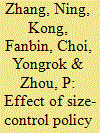

|
|
|
|
|
| Publication |
2014.
|
| Summary/Abstract |
This paper examines the effect of size control policy on the energy and carbon efficiency for Chinese fossil fuel power industry. For this purpose, we propose two non-radial directional distance functions for energy/carbon efficiency analysis of fossil fuel electricity generation. One is named a total-factor directional distance function that incorporates the inefficiency of all input and output factors to measure the unified (operational and environmental) efficiency of fossil fuel power plants, and the other is called an energy-environmental directional distance function that can be used to measure the energy-environmental performance of fossil fuel electric power plants. Several standardized indicators for measuring unified efficiency and energy-environmental performance are derived from the two directional distance functions. An empirical study of 252 fossil fuel power plants in China is conducted by using the proposed approach. Our empirical results show that there exists a significant positive relationship between the plant size and unified efficiency, the five state-owned companies show lower unified efficiency and energy-environmental performance than other companies. It is suggested that Chinese government might need to consider private incentives and deregulation for its state-owned enterprises to improve their performance proactively.
|
|
|
|
|
|
|
|
|
|
|
|
|
|
|
|
| 6 |
ID:
132771
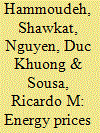

|
|
|
|
|
| Publication |
2014.
|
| Summary/Abstract |
We use a quantile regression framework to investigate the impact of changes in crude oil prices, natural gas prices, coal prices, and electricity prices on the distribution of the CO2 emission allowance prices in the United States. We find that: (i) an increase in the crude oil price generates a substantial drop in the carbon prices when the latter is very high; (ii) changes in the natural gas prices have a negative effect on the carbon prices when they are very low but have a positive effect when they are quite high; (iii) the impact of the changes in the electricity prices on the carbon prices can be positive in the right tail of the distribution; and (iv) the coal prices exert a negative effect on the carbon prices.
|
|
|
|
|
|
|
|
|
|
|
|
|
|
|
|
| 7 |
ID:
132827


|
|
|
|
|
| Publication |
2014.
|
| Summary/Abstract |
This study challenges the implicit assumption of homogeneity in national institutional contexts made in past studies of (renewable) energy policy. We propose that institutional differences matter by focusing on several technology-specific and generic policy factors that can foster technology diffusion through private sector activity. More specifically, we explore perceptions of early adopters in emerging economy contexts using wind park project developers as an example. By applying a parsimonious method for our questionnaire as well as qualitative data we make several contributions: Methodologically, we introduce Maximum Difference Scaling to the energy policy domain. Empirically, we identify several public influences on private investment, and assess their relative importance. This leads to new insights challenging findings from industrialized economies; we identified additional institutional barriers to diffusion, hence, the requirement of a combination of technology-specific and generic policy measures.
|
|
|
|
|
|
|
|
|
|
|
|
|
|
|
|
| 8 |
ID:
132790


|
|
|
|
|
| Publication |
2014.
|
| Summary/Abstract |
This paper explores people×s preferences for a Built in Photovoltaic (BIPV) renewable energy system to be integrated into housing construction. A novel methodology was developed, to study the case of Northern Cyprus, for better understanding of possibilities that abound in BIPV integration. The methodology incorporates Building Information Modeling (BIM) as a real-time design and economic assessment tool for BIPV choices. This serves to benefit both the construction companies and potential house owners in their decision-making. In addition, it uses a Contingent Valuation (CV) method to assess the Willingness to Pay (WTP) and the Willingness to Accept (WTA) compensation. The results indicate that the capital cost of PV is not instrumental in choice, and a lower feed-in tariff could be acceptable.
|
|
|
|
|
|
|
|
|
|
|
|
|
|
|
|
| 9 |
ID:
132767


|
|
|
|
|
| Publication |
2014.
|
| Summary/Abstract |
Governments deciding to use nuclear energy as part of their country×s energy mix are faced with long-term planning efforts and huge investments. As nuclear power plants constitute one of the socially and politically most contested technologies, the question arises, which time horizons companies as well as politicians have to consider for the accomplishment and grid-connection of individual and whole fleets of reactors. Unfortunately, there are no large-N studies investigating the time for completion of such large-scale projects. For the first time, we statistically explain the duration of the construction of all initiated nuclear plant projects so far. Based on the International Atomic Energy×s comprehensive Power Reactor Information System (PRIS) we assess the impact of demographic, economic, and political preconditions of a country, at the same time accounting for different types of reactor technologies. To account for non-linear relationships, we apply non-parametric survival models with P-splines. A main result of our analysis is that time of connection to grid increases over the years indicating increased societal sensibilities, respect for higher security standards, and increased project complexities. The Harrisburg and the Chernobyl disaster did not induce a separate additional delaying effect.
|
|
|
|
|
|
|
|
|
|
|
|
|
|
|
|
| 10 |
ID:
132762
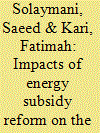

|
|
|
|
|
| Publication |
2014.
|
| Summary/Abstract |
Malaysia is paying a high level of subsidies on the consumption of energy (about 5% of its GDP). Therefore, reforming the energy subsidies, as planned by the government, will have a significant impact on household welfare and energy-intensive sectors, such as the transport sector. This study employs a computable general equilibrium (CGE) model to highlight the transmission channels through which the removal of energy subsidies affects the domestic economy. The findings show that the shock increases real GDP and real investment, while decreasing Malaysian total exports and imports. The removal of energy subsidies also decreases the aggregate energy demand, and, consequently, decreases the level of carbon emissions in the Malaysian economy. In addition, households experience significant falls in their consumption and welfare. The transport sector is significantly influenced through an increase in production costs due to an increase in the prices of intermediate inputs. The total output and total exports of the whole transport sector decrease while its imports increase. In addition, the use of all kinds of transport by households decreases significantly. The Malaysian energy subsidy reform, leads to an initial decrease in CO2 emissions and demand for electricity, gas, and petroleum products in the entire transport sector.
|
|
|
|
|
|
|
|
|
|
|
|
|
|
|
|
| 11 |
ID:
132766


|
|
|
|
|
| Publication |
2014.
|
| Summary/Abstract |
The aim of this study is to place the notion of energy security under critical scrutiny by unpacking how different actors manipulate the term through the mobilization of existential language as a prism for creating securitization discourse. Through an examination of an Israeli inter-ministerial committee charged with developing national policy regarding newly-discovered natural gas reserves off the coast of Israel, the study finds that the concept of energy security is open for manipulation and various interpretations. While some actors stress environmental acceptability and independency as pillars of energy security, others prioritized supply reliability and geopolitical benefits associated with gas exportation. Each definition of energy security was also found to be anchored in different ideologies, goals, policies and legitimizing factors. The coupling of energy with securitization rhetoric was ultimately determined as working against cooperative efforts, as committee conflicts intensified and suggested institutional measures became disproportional.
|
|
|
|
|
|
|
|
|
|
|
|
|
|
|
|
| 12 |
ID:
132765


|
|
|
|
|
| Summary/Abstract |
The aim of this study is to place the notion of energy security under critical scrutiny by unpacking how different actors manipulate the term through the mobilization of existential language as a prism for creating securitization discourse. Through an examination of an Israeli inter-ministerial committee charged with developing national policy regarding newly-discovered natural gas reserves off the coast of Israel, the study finds that the concept of energy security is open for manipulation and various interpretations. While some actors stress environmental acceptability and independency as pillars of energy security, others prioritized supply reliability and geopolitical benefits associated with gas exportation. Each definition of energy security was also found to be anchored in different ideologies, goals, policies and legitimizing factors. The coupling of energy with securitization rhetoric was ultimately determined as working against cooperative efforts, as committee conflicts intensified and suggested institutional measures became disproportional.
|
|
|
|
|
|
|
|
|
|
|
|
|
|
|
|
| 13 |
ID:
132829


|
|
|
|
|
| Publication |
2014.
|
| Summary/Abstract |
In a regulated world where government seeks to decarbonize the energy sector, firms face both indirect and direct costs of emitting CO2. This study seeks to take the perspective of the firm, which needs to maximize profits implying minimization of (carbon) cost as well. In this study, the firm can compose the cost-optimal portfolio of (a) investing into carbon-saving technology, which is currently expensive, (b) investing into carbon-saving technology R&D and adopt this technology at a later point, (c) buying allowances per ton of emitted CO2 in a carbon market (alternatively this could be formulated as a tax), and (d) buying offsets traded in the same market, which are based on reduced emissions from deforestation and degradation (REDD+). Uncertainties in the cost of carbon coming from a lack of commitment in policy-making leading to fluctuations in markets and uncertainty in the payoff of R&D activities could provide disincentives to incur large up-front sunk cost and raise the economic value of being flexible. We apply a real options approach with stochastic carbon-saving technology costs and stochastic CO2 costs. Assuming that firms are risk-averse, they will not only value flexibility, but also risk reductions from diversification over the different (carbon mitigation) options.
|
|
|
|
|
|
|
|
|
|
|
|
|
|
|
|
| 14 |
ID:
132748
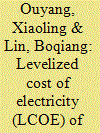

|
|
|
|
|
| Publication |
2014.
|
| Summary/Abstract |
The development and utilization of renewable energy (RE), a strategic choice for energy structural adjustment, is an important measure of carbon emissions reduction in China. High cost is a main restriction element for large-scale development of RE, and accurate cost estimation of renewable power generation is urgently necessary. This is the first systemic study on the levelized cost of electricity (LCOE) of RE in China. Results indicate that feed-in-tariff (FIT) of RE should be improved and dynamically adjusted based on the LCOE to provide a better support of the development of RE. The current FIT in China can only cover the LCOE of wind (onshore) and solar photovoltaic energy (PV) at a discount rate of 5%. Subsidies to renewables-based electricity generation, except biomass energy, still need to be increased at higher discount rates. Main conclusions are drawn as follows: (1) Government policy should focus on solving the financing problem of RE projects because fixed capital investment exerts considerable influence over the LCOE; and (2) the problem of high cost could be solved by providing subsidies in the short term and more importantly, by reforming electricity price in the mid-and long-term to make the RE competitive.
|
|
|
|
|
|
|
|
|
|
|
|
|
|
|
|
| 15 |
ID:
132757


|
|
|
|
|
| Publication |
2014.
|
| Summary/Abstract |
In the UK electricity market, generators are obliged to produce part of their electricity with renewable energy resources in accordance with the Renewable Obligation Order. Since 2009 technology banding has been added, meaning that different technologies are rewarded with a different number of certificates. We analyze these two different renewable obligation policies in a mathematical representation of an electricity market with random availabilities of renewable generation outputs and random electricity demand. We also present another, alternative, banding policy. We provide revenue adequate pricing schemes for the three obligation policies. We carry out a simulation study via sampling. A key finding is that the UK banding policy cannot guarantee that the original obligation target is met, hence potentially resulting in more pollution. Our alternative provides a way to make sure that the target is met while supporting less established technologies, but it comes with a significantly higher consumer price. Furthermore, as an undesirable side effect, we observe that a cost reduction in a technology with a high banding (namely offshore wind) leads to more CO2 emissions under the UK banding policy and to higher consumer prices under the alternative banding policy.
|
|
|
|
|
|
|
|
|
|
|
|
|
|
|
|
| 16 |
ID:
132769


|
|
|
|
|
| Publication |
2014.
|
| Summary/Abstract |
Forthcoming carbon dioxide (CO2) regulations for existing power plants in the United States have heightened interest in thermal efficiency gains for coal-fired power plants. Plant modifications to improve thermal efficiency can trigger New Source Review (NSR), a Clean Air Act requirement to adopt of state-of-the-art pollution controls. This article explores whether existing coal plants would likely face additional pollution control requirements if they undertake modifications that trigger NSR. Despite emissions controls that are or will be installed under the Mercury and Air Toxics Standards (MATS) and Clean Air Interstate Rule (CAIR) or its replacement, 80% of coal units (76% of capacity) that are expected to remain in operation are not projected to meet the minimum NSR requirements for at least one pollutant: nitrogen oxides or sulfur dioxide. This is an important consideration for the U.S. Environmental Protection Agency and state policymakers as they determine the extent to which CO2 regulation will rely on unit-by-unit thermal efficiency gains versus potential flexible compliance strategies such as averaging, trading, energy efficiency, and renewable energy. NSR would likely delay and add cost to thermal efficiency projects at a majority of coal units, including projects undertaken to comply with forthcoming CO2 regulation.
|
|
|
|
|
|
|
|
|
|
|
|
|
|
|
|
| 17 |
ID:
132747
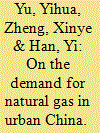

|
|
|
|
|
| Publication |
2014.
|
| Summary/Abstract |
Using a set of unbalanced panel data for Chinese×s cities during the period of 2006-2009, this study aims to estimate the price and income elasticities of residential demand for natural gas. Natural gas consumption is specified as a function of its own price; substitute prices; urban wages; and other supply, climate, and housing characteristics. Using a feasible generalised least squares (FGLS) technique, which controls for panel heteroskedasticity and panel correlation, we find that natural gas consumption is price elastic and income inelastic when other covariates (e.g., the supply of natural gas pipeline and heating degree days) are controlled. In addition, there are large variations in demand behaviours across China×s regions. There is a substantial income effect on demand for natural gas in southern China, whereas the northern regions are found to have a higher price effect. In addition, the substitution effect between coal and natural gas is significant in North China but is not significant in South China. These findings have several important policy implications for natural gas pricing and supply cost analysis in the context of China.
|
|
|
|
|
|
|
|
|
|
|
|
|
|
|
|
| 18 |
ID:
132764


|
|
|
|
|
| Publication |
2014.
|
| Summary/Abstract |
With the reduction of global oil reserves, developing renewable energy has become an important issue for each country. Biomass power is an important kind of clean energy, as it has abundant resource and is environmental friendly. In the past few years, China biomass power industry has developed rapidly accompanied with some problems. This paper analyzes the current situation of China biomass power generation from several aspects such as power structure, resource distribution, investment strength, and policy environment, etc. We focus on the problems existed in practical operation and analyze the outstanding problems. At last, this paper offers several suggestions for future development on the relevant fields, such as cost, strategic planning and policy.
|
|
|
|
|
|
|
|
|
|
|
|
|
|
|
|
| 19 |
ID:
132759


|
|
|
|
|
| Publication |
2014.
|
| Summary/Abstract |
This paper explores the response by members of the lay public to the prospect of an onshore CO2 pipeline through their locality as part of a proposed CCS development and presents results from deliberative Focus Groups held along a proposed pipeline route. Although there is a reasonable level of general knowledge about CO2 across the lay public, understanding of its specific properties is more limited. The main concerns expressed around pipelines focused on five areas: (i) safe operation of the pipeline; (ii) the risks to people, livestock and vegetation arising from the leakage of CO2 from the pipeline; (iii) the innovative and 'first of its kind× nature of the pipeline and the consequent lack of operational CO2 pipelines in the UK to demonstrate the technology; (iv) impacts on coastal erosion at the landfall site; and (v) the potential disruption to local communities during pipeline construction. Participants expressed scepticism over the motivations of CO2 pipeline developers. Trust that the developer will minimise risk during the route selection and subsequent construction, operation and maintenance of the pipeline is key; building trust within the local community requires early engagement processes, tailored to deliver a variety of engagement and information approaches.
|
|
|
|
|
|
|
|
|
|
|
|
|
|
|
|
| 20 |
ID:
132758


|
|
|
|
|
| Publication |
2014.
|
| Summary/Abstract |
This paper analyses the impact of global economic activity and international crude oil prices on natural gas import prices in three major natural gas markets using the panel cointegration model. It also investigates the shock impacts of the volatility and the increase and decrease of oil prices on regional natural gas import prices. The results show that both global economic activity and international crude oil prices have significant long-term positive effects on regional natural gas import prices. The volatility of international crude oil prices has a negative impact on regional natural gas import prices. The shock impact is weak in North America, lags in Europe and is most significant in Asia, which is mainly determined by different regional policies for price formation. In addition, the response of natural gas import prices to increases and decreases in international crude oil prices shows an asymmetrical mechanism, of which the decrease impact is relatively stronger.
|
|
|
|
|
|
|
|
|
|
|
|
|
|
|
|
|
|
|
|
|